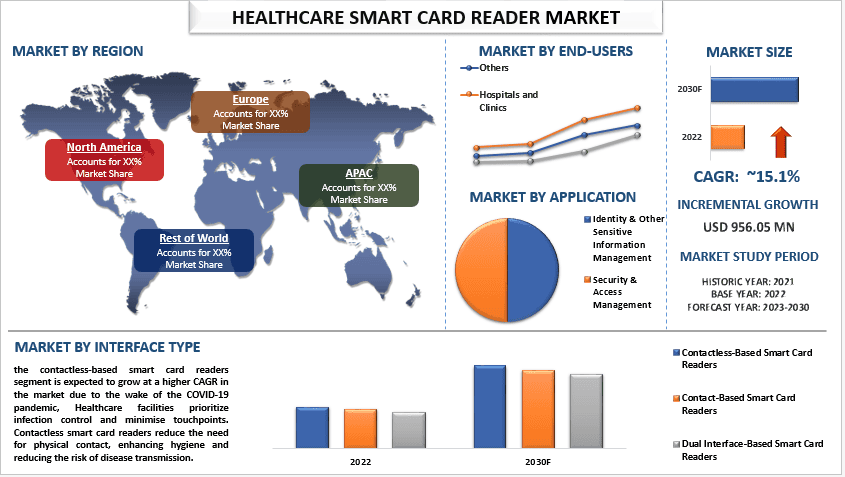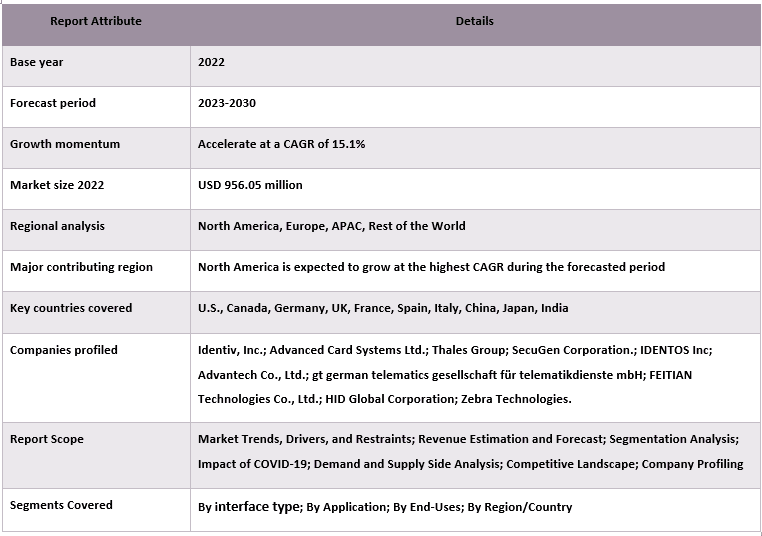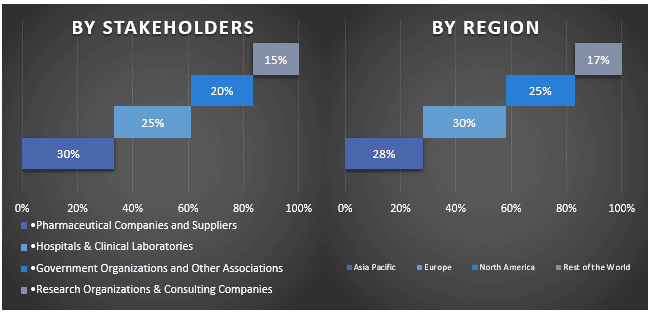
2022年,全球医疗保健智能卡读卡器市场价值为9.5605亿美元,预计从2023年到2030年将以15.1%的复合年增长率增长。医疗保健智能卡读卡器市场涉及智能卡读卡器设备的制造、分销和采用,这些设备专门设计用于医疗保健行业。这些设备用于读取智能卡,智能卡存储并提供对敏感患者信息、电子健康记录 (EHR) 和其他医疗保健相关数据的安全访问。医疗保健环境中的智能卡读卡器对于确保数据安全、患者隐私和高效的访问控制至关重要。EHR系统的广泛采用推动了对智能卡读卡器等安全访问控制解决方案的需求。这些读卡器帮助医疗保健专业人员安全地验证身份,以访问和更新患者记录。例如,截至2020年2月,根据美国国家卫生信息技术协调员办公室 (ONC) 的数据,美国89.7%的在办公室执业的医生采用了经过认证的EHR系统。此外,数据泄露风险的上升以及遵守严格数据保护法规的需求促使医疗保健组织投资于强大的数据安全解决方案,包括智能卡读卡器。例如,根据IBM数据泄露报告,2020年医疗保健行业数据泄露的全球平均成本为713万美元。
市场上一些主要参与者包括Identiv, Inc.;Advanced Card Systems Ltd.;Thales Group;SecuGen Corporation.; IDENTOS Inc; Advantech Co., Ltd.; gt german telematics gesellschaft für telematikdienste mbH; FEITIAN Technologies Co., Ltd.; HID Global Corporation; Zebra Technologies。这些参与者已经进行了多次并购和合作,以便为客户提供高科技和创新产品/技术。
报告中提出的见解
“在接口类型中,基于非接触式的智能卡读卡器细分市场在2023年占据了重要的市场份额。”
根据接口类型,市场分为基于接触式的智能卡读卡器、基于非接触式的智能卡读卡器和基于双接口的智能卡读卡器。其中,由于 COVID-19 大流行的影响,基于非接触式的智能卡读卡器细分市场预计将在市场上以更高的复合年增长率增长,医疗机构优先考虑感染控制并最大限度地减少接触点。非接触式智能卡读卡器减少了物理接触的需求,从而增强了卫生并降低了疾病传播的风险。非接触式技术可以实现更快的身份验证和访问,从而简化医疗保健工作流程。这在紧急情况或繁忙的医疗保健环境中尤为重要,因为时间至关重要。
“在应用方面,安全和访问管理细分市场在2023年占据了更高的复合年增长率。”
根据应用,市场分为身份和其他敏感信息管理以及安全和访问管理。其中,安全和访问管理细分市场预计将在市场上以更高的复合年增长率增长。医疗保健行业处理高度敏感的患者数据,使其成为网络攻击的主要目标。安全漏洞可能会产生严重的后果,包括经济处罚和声誉损害。强大的安全措施对于保护患者信息至关重要。此外,医疗保健组织必须遵守严格的数据保护法规,例如美国的《健康保险流通与责任法案》(HIPAA) 和欧盟的《通用数据保护条例》(GDPR)
“北美在2023年主导了医疗保健智能卡读卡器市场。”
在电子健康记录 (EHR) 的采用率不断提高、数据泄露风险的上升以及需要遵守严格的数据保护法规的推动下,以及COVID-19大流行加速了远程医疗和远程医疗保健服务的采用,预计北美医疗保健智能卡读卡器市场将在未来几年继续增长。智能卡读卡器对于虚拟医疗咨询期间的安全身份验证和数据访问至关重要。例如,根据疾病控制与预防中心 (CDC) 的报告,在美国,远程医疗服务的使用量在2020年增加了3,000%。
医疗保健智能卡读卡器市场报告覆盖范围

购买本报告的理由:
- 该研究包括由经过验证的关键行业专家验证的市场规模和预测分析。
- 该报告快速回顾了整体行业表现。
- 该报告深入分析了主要的行业同行,主要侧重于关键业务财务、产品组合、扩张战略和最新发展。
- 详细研究了行业中存在的驱动因素、限制、关键趋势和机遇。
- 该研究全面涵盖了跨不同细分市场的市场。
- 深入的行业区域层面分析。
定制选项:
全球医疗保健智能卡读卡器市场可以根据要求或任何其他市场细分进行进一步定制。此外,UMI 了解到您可能有自己的业务需求,因此请随时与我们联系以获取完全适合您需求的报告。
目录
医疗保健智能卡读卡器市场分析(2023-2030)的研究方法
分析历史市场、估计当前市场以及预测全球医疗保健智能卡读卡器市场的未来市场是创建和分析全球主要地区医疗保健智能卡读卡器应用情况的三个主要步骤。进行了详尽的二级研究,以收集历史市场数据并估计当前的市值。其次,为了验证这些见解,考虑了许多发现和假设。此外,还与全球医疗保健智能卡读卡器市场价值链中的行业专家进行了详尽的一级访谈。在通过一级访谈对市场数据进行假设和验证后,我们采用了自上而下/自下而上的方法来预测完整的市场规模。此后,采用市场细分和数据三角剖分方法来估计和分析行业相关细分市场和子细分市场的市场规模。详细方法如下解释:
历史市场规模分析
第 1 步:深入研究二级来源:
进行了详细的二级研究,通过公司内部来源(例如年度报告和财务报表、业绩演示文稿、新闻稿等)以及外部来源(包括期刊、新闻和文章、政府出版物、竞争对手出版物、行业报告、第三方数据库和其他可信出版物)来获取医疗保健智能卡读卡器市场的历史市场规模。
第 2 步:市场细分:
在获得医疗保健智能卡读卡器市场的历史市场规模后,我们进行了详细的二级分析,以收集主要地区不同细分市场和子细分市场的历史市场见解和份额。报告中包含的主要细分市场包括接口类型、应用和最终用户。此外,还进行了国家/地区层面的分析,以评估该地区测试模型的总体应用情况。
第 3 步:因素分析:
在获得不同细分市场和子细分市场的历史市场规模后,我们进行了详细的因素分析,以估计医疗保健智能卡读卡器市场的当前市场规模。此外,我们使用医疗保健智能卡读卡器市场的接口类型、应用和最终用户等因变量和自变量进行了因素分析。考虑到全球医疗保健智能卡读卡器市场领域的顶级合作、并购、业务扩张和产品发布,对需求侧和供应侧情景进行了全面分析。
当前市场规模估算与预测
当前市场规模确定:基于上述 3 个步骤的可操作见解,我们得出了全球医疗保健智能卡读卡器市场的当前市场规模、主要参与者以及细分市场的市场份额。所有必需的百分比份额拆分和市场细分均使用上述二级方法确定,并通过一级访谈进行验证。
估算与预测:对于市场估算和预测,为包括驱动因素和趋势、限制因素以及利益相关者可用的机会在内的不同因素分配了权重。在分析了这些因素后,应用相关的预测技术,即自上而下/自下而上的方法,以得出全球主要市场中不同细分市场和子细分市场的 2030 年市场预测。用于估算市场规模的研究方法包括:
- 该行业的市场规模,按收入(美元)计算,以及国内主要市场中医疗保健智能卡读卡器市场的采用率
- 所有百分比份额、拆分和市场细分以及子细分市场
- 全球医疗保健智能卡读卡器市场中的主要参与者(就提供的产品而言)。此外,这些参与者为在快速增长的市场中竞争而采取的增长策略
市场规模和份额验证
一级研究:与主要地区的关键意见领袖 (KOL) 进行了深入访谈,包括顶级管理人员(CXO/副总裁、销售主管、营销主管、运营主管、区域主管、国家/地区主管等)。然后对一级研究结果进行总结,并进行统计分析以证明所述假设。一级研究的输入与二级研究结果相结合,从而将信息转化为可操作的见解。
不同地区一级参与者的细分

市场工程
采用数据三角剖分技术来完成整体市场估算,并得出全球医疗保健智能卡读卡器市场每个细分市场和子细分市场的精确统计数据。在研究了全球医疗保健智能卡读卡器市场中接口类型、应用和最终用户领域的各种参数和趋势后,数据被分成多个细分市场和子细分市场。
全球医疗保健智能卡读卡器市场研究的主要目标
该研究指出了全球医疗保健智能卡读卡器市场的当前和未来市场趋势。投资者可以获得战略见解,从而根据研究中进行的定性和定量分析来决定投资。当前和未来市场趋势决定了区域层面市场的整体吸引力,从而为行业参与者提供了一个利用未开发市场以从先行者优势中受益的平台。该研究的其他定量目标包括:
- 分析当前和预测的医疗保健智能卡读卡器市场规模(按价值(美元)计算)。此外,分析不同细分市场和子细分市场的当前和预测的市场规模
- 研究中的细分市场包括接口类型、应用和最终用户领域
- 定义和分析医疗保健智能卡读卡器行业的监管框架
- 分析涉及各种中介机构的价值链,以及分析行业的客户和竞争对手行为
- 分析主要地区医疗保健智能卡读卡器市场的当前和预测的市场规模
- 报告中研究的区域的主要国家/地区包括亚太地区、欧洲、北美和世界其他地区
- 医疗保健智能卡读卡器公司的概况以及市场参与者为在快速增长的市场中维持发展而采取的增长战略
- 深入分析该行业的区域层面
相关 报告
购买此商品的客户也购买了










